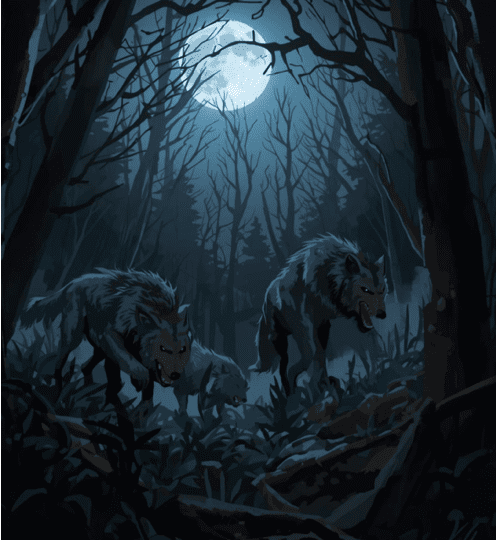Long before the modern age, in the heart of ancient Europe, there existed a remote village nestled within the shadowy embrace of a dense, enchanted forest. The villagers whispered of a mysterious curse said to be born from the depths of the woods. This curse transformed humans into fearsome creatures under the light of the full moon—werewolves.
The Curse of Lycaon
The legend traces back to a tale of pride and punishment. According to ancient folklore, King Lycaon of Arcadia was a proud and arrogant ruler. He dared to test the omniscience of the gods by serving Zeus, the king of the gods, a meal that was unfit for divine consumption. Enraged by this hubris, Zeus transformed Lycaon into a wolf, condemning him and his descendants to roam the earth as creatures of the night. The curse ensured that under the full moon, the descendants of Lycaon would transform into wolves, driven by an insatiable hunger.
The Spread of the Legend
As centuries passed, the tale of Lycaon and his descendants spread across Europe. Each culture added its own spin to the lore, and the legend of the werewolf evolved. In France, the loup-garou became a prominent figure in folklore, while in Germany, the werwulf was feared by those who ventured too close to the forest.
The association of werewolves with the moon became a universal element in the tales. It was believed that the full moon’s light was a catalyst for transformation, awakening the beast within. The howls of wolves echoing through the night were thought to be the cries of those trapped in their cursed forms.
Werewolves and Halloween
The connection between werewolves and Halloween emerged during the medieval period, as the festival of Samhain evolved into what we now know as Halloween. Samhain marked the end of the harvest and the beginning of winter, a time when the boundary between the living and the dead was believed to be at its thinnest. People would light bonfires and wear costumes to ward off roaming spirits.
As part of the festivities, tales of supernatural creatures were shared, and the fearsome image of the werewolf fit perfectly into the eerie atmosphere of Halloween. People began to dress as werewolves, using costumes and masks to embody the creatures that haunted their nightmares.
Modern-Day Werewolves
Today, werewolves continue to captivate our imaginations. They are a staple in literature, film, and popular culture, often portrayed as symbols of duality—human one moment and beast the next. Whether in horror stories or as misunderstood anti-heroes, werewolves remain an integral part of Halloween lore, embodying the thrill and terror of the supernatural.
The legend of the werewolf, with its origins steeped in ancient myth and cultural evolution, has cemented its place in the tapestry of Halloween. It reminds us of our primal fears and the thin line that separates the human from the beast, especially under the glow of an autumn moon.




